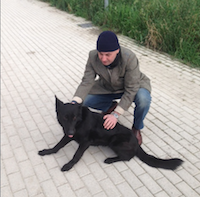Article
Man's best friend may also help detect prostate cancer
It is hard to imagine a world without dogs. Since the beginning of civilization, from hunting to herding, dogs have literally been man's best friend. Now, canines are being enlisted to help with a major health problem of the modern age: prostate cancer detection.

Brian Stork, MD
Blogger Profile
Dr. Stork serves on the AUA Social Media Committee and is social media director at StomaCloak. He is a private practice urologist at West Shore Urology in Muskegon, MI.
Note: Most of this video does not contain sound.
It is hard to imagine a world without dogs. Since the beginning of civilization, from hunting to herding, dogs have literally been man's best friend. Now, canines are being enlisted to help with a major health problem of the modern age: prostate cancer detection.
is a urologic surgeon at the Humanitas Research Hospital in Milan, Italy. He and his colleague, biologist Fabio Grizzi, PhD, collect urine samples from men with prostate cancer in Milan.
The urine samples are then transported, frozen, to Lorenzo Tidu, VMD, a veterinary surgeon at the Italian Ministry of Defense Military Veterinary Center in Grosseto, about 270 miles away. Once in Grosseto, bomb-sniffing dogs are enlisted to determine whether volatile organic compounds (VOCs) in urine can be used to detect the presence of prostate cancer in men.
Not your average dogs
The dogs being used in the study are not your average German shepherds. Liù and Zoe are highly specialized military dogs who have undergone months of extensive training, with experienced handlers, prior to the start of this study. In a press briefing at the AUA annual meeting in Orlando, Dr. Taverna explained that "these animals are the Ferraris of the dog world."
Continue to next page for more.
Passing the test

Gianluigi Taverna, MD, pictured along with Lorenzo Tidu, VMD, and his team of veterinarians, trainers, and handlers. Also pictured are dogs Liù (left) and Zoe.In this study, Liù and Zoe tested the urine samples of 362 men with prostate cancer and 540 men without prostate cancer. Liù was 100% sensitive and 98% specific and Zoe was 98% sensitive and 96% specific in detecting urine VOCs in men with prostate cancer.
Dr. Taverna's work builds upon the work of Jean-Nicolas Cornu, MD, who, in 2011, reported on a dog that was able to correctly detect VOCs in men with prostate cancer 30 out of 33 times.
Exact compounds unknown
The nature of the compounds the dogs are detecting in the urine samples of men with prostate cancer are currently unknown. This presents an exciting opportunity for future study. Theoretically, if specific compounds could be identified, an instrument could be used to detect them.
Dr. Taverna points out, however, that the canine olfactory system is a biologic wonder. In the military, for example, when it comes to detecting explosives, there is currently no instrument that can compare with a dog's sense of smell.
The possibility of using dogs to identify men with prostate cancer is something most would have never considered possible even a decade or two ago. Long term, the challenge will be to see whether a clinical model can be developed and scaled to present men with an alternative to the current methods of prostate cancer screening and detection.
Like this article? Check out some other recent Urology Times blog posts:
IOASE repeal efforts threaten coordinated care
The great prostate cancer 'hoax': A call to arms
The Affordable Care Act: A urologist's survival guide
To get weekly news from the leading news source for urologists, subscribe to the Urology Times eNews.





